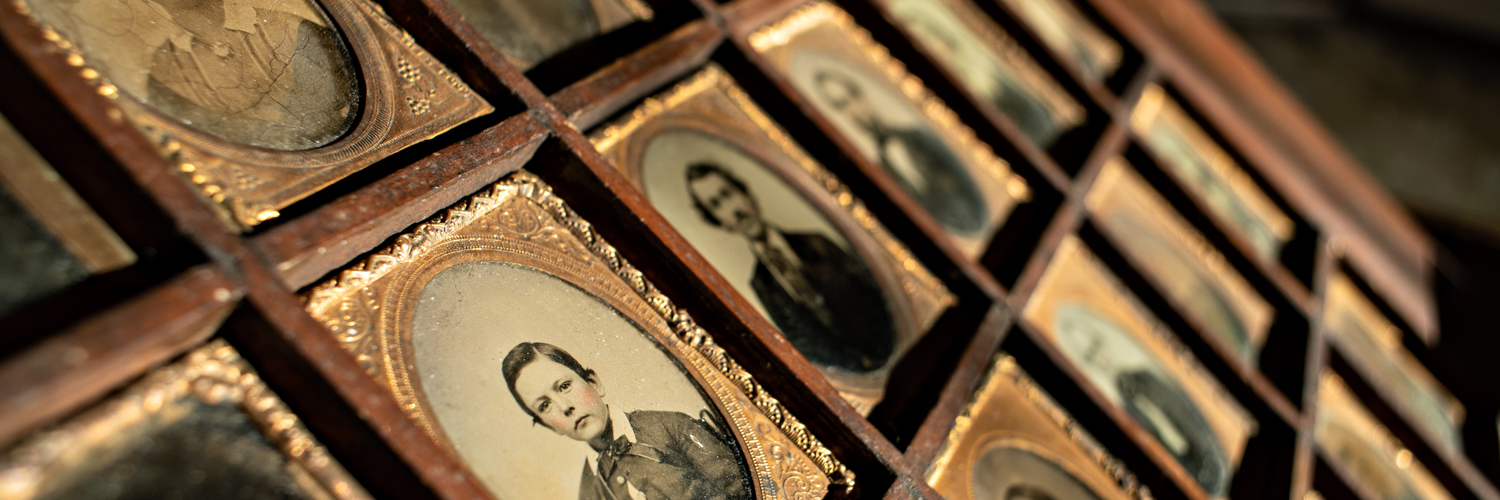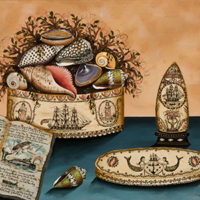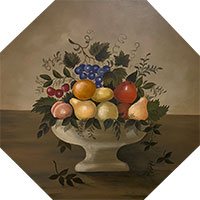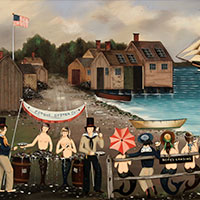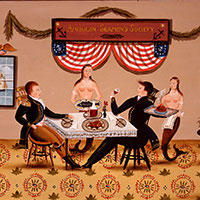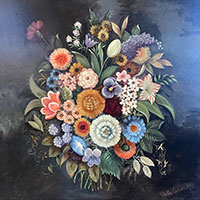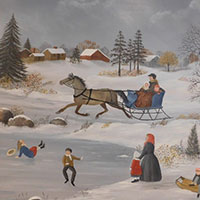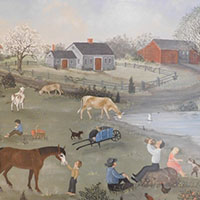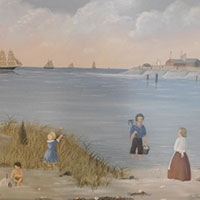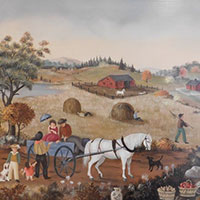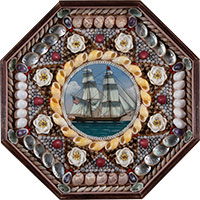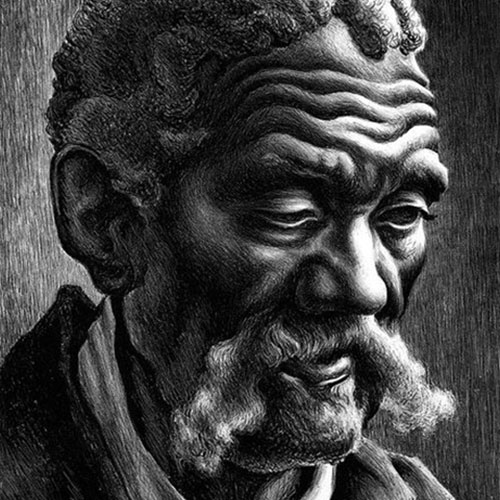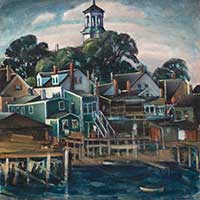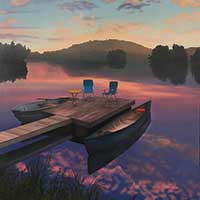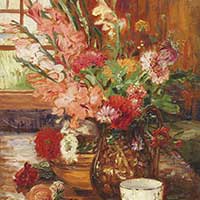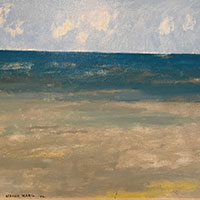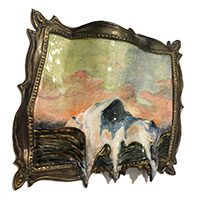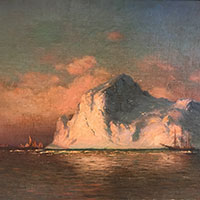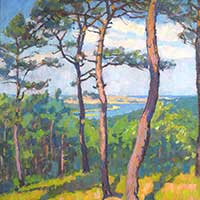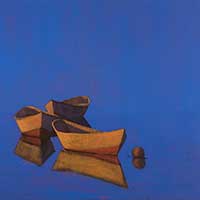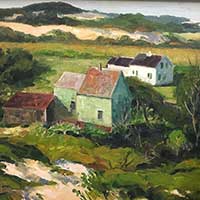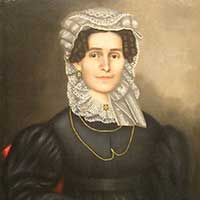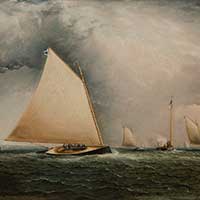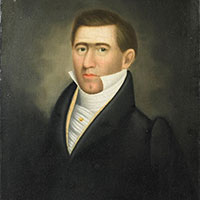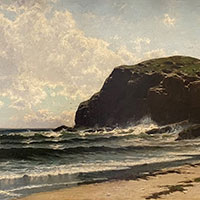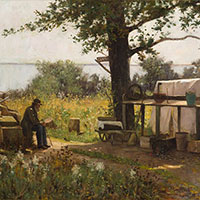The Cahoon Museum of American Art has a collection of art representing nearly every medium, including paintings, three-dimensional art, works on paper, and furniture dating from the 18th century to the present.
Founded in 1984, the Cahoon Museum of American Art was the vision of art historian and art collector Rosemary Rapp. Motivated by a desire to preserve the story, artwork, and the historic building that served as the home and studio of Cape Cod artists Ralph Cahoon (1910-1982) and Martha Cahoon (1905-1999), who were decorative furniture painters as well as folk artists, Rapp also envisioned the Cahoon Museum as a vast repository of American art that would serve as a cultural resource for the community with a broad mission promoting education and the enjoyment of art.
An avid collector of early American and 19th century artwork, Rapp seeded the museum’s collection with a promised gift of artworks including paintings by William Bradford, James E. Buttersworth, and John Enneking as well as a group of early American paintings including portraits by Erastus Salisbury Fields and William Matthew Prior.
The Cahoon Museum’s collection has grown by donation, bequest, and acquisitions over the past three decades. The Museum’s commitment to collecting works of the highest quality has been supported by Patrons members including the Director’s Circle and Cahoon Society and through the generous donations of many collectors whose gifts enable the museum to further its mission of celebrating American art.
Collection highlights include works by 20th century artists of the Cape Ann and Provincetown art colonies, including Edna Choate Hodgkins, Daisy Margaret Hughes, Margaret Jordan Patterson, as well as a broad selection of contemporary New England artists. Another collection focus includes a grouping of art and ephemera by the Cape Cod folk artists Ralph (1910-1982) and Martha (1905-1999) Cahoon.
Because the Cahoon Museum has a small, but growing, collection of over 400 artworks, the Museum leads with its strength in exhibitions. Over the years, the museum has gained a reputation for curating creative, high-quality exhibitions on individual artists as well as group and themed exhibitions. Most recently, the exhibitions have combined historic American art with contemporary art in conversation.
This interchange of old and new is directly connected to our facilities, as the museum is housed in a historic building with a modern gallery addition. Displaying art in a historic house can be a challenge as we have to work with the available wall space and unique architectural features. But it also inspires innovation. The house carries the patina of age and layers of decoration – early American stenciling in the front stairway and 20th century wall and floor stencils by the Cahoons, for example – and this influences interpretation of artwork by either grounding it within the intimate setting of a domestic space or promoting a contrast between new art and the historic living spaces. The room-sized galleries in the historic building give us a chance to display smaller scale art and concentrated groupings.
The Cahoon Museum has a strong connection to Ralph (1910-1982) and Martha Cahoon (1905-1999) because the Museum’s historic building was once their home and art studio. Not only were the Cahoons good stewards of the historic home, they had a deep love of American history. Mixing the Museum’s collection of American art with paintings and painted furniture by the Cahoons works well because of their nostalgic references to history.
The Museum’s collection of artwork by Ralph and Martha Cahoon adds a strong folk art flavor, which I really enjoy. I consider the Cahoons’ sense of whimsy and nostalgia for American history very important ingredients to the Cahoon Museum’s uniqueness. There is a license to collect and exhibit artwork that falls outside of traditional genres, either in terms of subject matter or material; keeping in the spirit of the Cahoons gives us permission to be unconventional and have fun with surprising combinations of historic reference and pure imagination. The Cahoons’ story is also deeply connected to a specific time and culture in Cape Cod history, which – along with the Crocker home – delivers a strong sense of authenticity. It is a special and very unique connection to Cape Cod and New England.
The Cahoon Museum has had a slow and careful approach to growing its collection, knowing that preserving artwork in perpetuity requires many resources, including museum-quality storage space, staff to manage and interpret the art, and conservation and preservation funding. We acquire works through gifts and donations, including bequests, and also through purchase. The Cahoon Society and Director’s Circle patron groups have provided annual funding for artwork purchases, and many of the Museum’s most important paintings have come through the generosity of this collecting group. By thoughtfully and intentionally building a collection, the Cahoon Museum ensures that new additions have a connection to core pieces or fill in a gap in a collecting area the museum wishes to develop.
As the Cahoon Museum collection grows, I keep in mind the vision of where the Cahoon is going. As a regional museum with roots in Cape Cod, I think of the legacy as an organization that we are leaving for our community – both locally and throughout New England.
Crocker family photographs
Composite collection: ambrotypes, tintypes, wood frame
Gift of Susan and Zenas Crocker, VII
2018.11
The recent acquisition of this group of family portraits inspired the Cahoon Museum to present its first major exhibition of historical photography, Through the Looking Glass: Masterpieces from the Dawn of Photography.
This framed portrait composite was donated by Zenas Crocker, VII, and it portrays members of the Crocker family -as yet identified- many of whom lived in the Crocker house (now the Museum’s historic building) in the late 19th century. Who are the women, children, and men captured in these photographs? Geneological researchers at the Cahoon Museum hope to reveal more about the names and lives of the Cape Codders in these early fixed images.
OUR COLLECTION
We are continuously adding works from our collection, view below and check back often.
The Cahoons
Ralph Cahoon (1910-1982)
Still Life with Logbook and Scrimshaw, c. 1960s
Ralph Cahoon (1910-1982)
Still Life with Logbook and Scrimshaw, c. 1960s
Oil on masonite
Promised Gift to the Cahoon Museum of American Art
This still life reflects Ralph’s interest in nautical antiques. The objects are rendered with a combination of realism and fantasy – note the reference to a mermaid sighting in the logbook. First Lady Jacqueline Kennedy and her sister-in-law Jean Kennedy Smith bought two paintings apiece during a 1961 visit to the artists’ Cotuit studio. Years later, Martha recalled the visit as follows:
The big black car drove up, and I immediately recognized Jackie…I went out to get Ralph, who was out mowing the lawn. He had grass stains all over him. He didn’t clean himself off; he just rushed in to meet them. But I knew Ralph would have killed me if I didn’t let him know.
At some point Mrs. Kennedy apparently saw a painting in the vein of Still Life with Logbook and Scrimshaw in the Cahoons’ studio. Reputedly, she later sought to buy the piece for President Kennedy, who had begun collecting scrimshaw, so was disappointed to learn it had sold in the interim. At her request, Ralph asked the owners if they would sell it to her, but they declined, saying they had grown too fond of it.
Martha Cahoon (1905-1999)
Fruit Still Life, n.d.
Martha Cahoon (1905-1999)
Fruit Still Life, n.d.
Oil on masonite
Collection of the Cahoon Museum of American Art
Gift of Franz Cahoon
1987.1
Ralph Cahoon (1910-1982)
Cotuit Oyster Company, c.1950s
Ralph Cahoon (1910-1982)
Cotuit Oyster Company, c. 1950s
Oil on masonite
Collection of the Cahoon Museum of American Art
Gift of Keith and Rosemary Rapp
1986.16
Ralph Cahoon (1910-1982)
American Seaman’s Society, n.d.
Ralph Cahoon (1910-1982)
American Seaman’s Society, n.d.
Oil on masonite
Collection of the Cahoon Museum of American Art
Gift of a Trustee of the Cahoon Museum of American Art
2019.1
Martha Cahoon (1905-1999)
Still Life Bouquet, 1965
Martha Cahoon (1905-1999)
Still Life Bouquet, 1965
Oil on canvas
Promised Gift to the Cahoon Museum of American Art
Martha Cahoon (1905-1999)
Sleigh Scene, Winter, 1981
Martha Cahoon (1905-1999)
Sleigh Scene, Winter, 1981
Oil on masonite
Collection of the Cahoon Museum of American Art
Gift of the Cahoon Society, 2018
2018.5
Martha Cahoon (1905-1999)
Spring Scene, 1981
Martha Cahoon (1905-1999)
Spring Scene, 1981
Oil on masonite
Collection of the Cahoon Museum of American Art
Gift of the Cahoon Society, 2018
2018.6
Martha Cahoon (1905-1999)
Clamming Scene, Summer, 1981
Martha Cahoon (1905-1999)
Clamming Scene, Summer, 1981
15 ½ x 11 ½ inches
Oil on masonite
Collection of the Cahoon Museum of American Art
Gift of the Cahoon Society 2018
2018.7
Martha Cahoon (1905-1999)
Harvest Scene, Fall, 1981
Martha Cahoon (1905-1999)
Harvest Scene, Fall, 1981
Oil on masonite
Collection of the Cahoon Museum of American Art
Gift of the Cahoon Society, 2018
2018.4
Ralph Cahoon (1910-1982)
and Bernard Woodman (1920-1986)
Sailor’s Valentine with Clipper Ship, c. 1980
Ralph Cahoon (1910-1982) and Bernard Woodman (1920-1986)
Sailor’s Valentine with Clipper Ship, c. 1980
Oil on masonite, shellwork on board
Promised Gift to the Cahoon Museum of American Art
Thomas Hart Benton (1889-1975)
Aaron, 1941
Thomas Hart Benton (1889-1975)
Aaron, 1941
Oil and egg tempera on canvas, mounted on plywood
30 5/16 x 24 5/16
Collection of the Pennsylvania Academy of Fine Arts
Joseph E. Temple Fund
1943.3
Thomas Hart Benton (April 15, 1889 – January 19, 1975) was a major American painter and muralist. After the war Benton began traveling throughout the United States, capturing his vision of the country’s different regions. Through his large murals, landscapes, and portraits, Benton gained national recognition, leading President Harry S. Truman to call him “the best damned painter in America.” Benton taught for several years at the Art Students League, where he would influence a new generation of American artists, including Jackson Pollock.
Benton was the most prominent of the American Regionalists, a term that refers to a group of artists, including Grant Wood and John Steuart Curry, who depicted folk culture during the 1920s. In returning to his native roots, Benton developed an unpretentious realism, extolling the simple virtues of life in the American heartland. In Aaron, he depicts Ben Nichols, an elderly farmer, with tattered clothes. Set against a neutral background, the subject’s face reveals the wear and tear of agrarian life, while Benton’s populist visual language defines this work as thoroughly American.
The lithograph in the Cahoon Museum’s collection relates to a painting, Aaron, in the collection of the Pennsylvania Academy of Fine Arts. Benton would often create a series of lithographic prints of his artwork which made owning art achievable for those who could not afford to buy a painting.
Interestingly, though Benton’s work is strongly associated with the Midwestern United States, he lived and worked in New York City for more than 20 years, summered for 50 years on Martha’s Vineyard, and also painted scenes of the American South and West.
Nancy Maybin Ferguson (1872-1967)
Provincetown Waterfront, c. 1930s
Nancy Maybin Ferguson (1872-1967)
Provincetown Waterfront, c. 1930s
Oil on board
Collection of the Cahoon Museum of American Art
Gift of the Cahoon Society, 2019
2019.3
Early Modernist painter Nancy Maybin Ferguson was a member of the artist’s group, the Philadelphia Ten. She spent the greater part of her life in two locations: Philadelphia, PA and Provincetown, MA. Her education included twenty years of art school at the Philadelphia School of Design for Women and at the Pennsylvania Academy of Fine Arts. She won and impressive number of fellowships for travel abroad.
Ferguson’s teachers included William Merritt Chase and Charles Hawthorne, who conducted summer school in Provincetown. She described Provincetown with its “Portuguese inhabitants of fishermen and their families, its narrow streets with beautiful cottonwood trees, its churches with their lovely steeples. The town was built close to the shore of the bay with many side streets climbing the hills of the sand dunes that looked down over the main art of the town, thus giving a variety of subjects to the painter.” She explained, “I liked to paint the streets, crowded with people, happy when carts, automobiles and people did not block my view, and strangers ask no questions.”
Ferguson’s painting adds to the Museum’s holdings of early Modernist women artists, and her work is attractive for its synthesis of styles. This painting of the Provincetown waterfront is broadly impressionistic and somewhat cubist, with a heavy impasto hand.
Scott Prior (B. 1949)
River at Sunrise, 2017-2019
Scott Prior (B. 1949)
River at Sunrise, 2017-2019
Oil on canvas
Collection of the Cahoon Museum of American Art
Gift of the Cahoon Society, 2019
2019.2
Native New Englander Scott Prior lives and works in Northampton, MA and has a long connection to Cape Cod. In the summer of 1969, while working washing dishes in a Provincetown restaurant, Prior hung some of his paintings on a fence on Commercial Street for sale. His paintings were so popular, he says that washing dishes was his “last real job.”
Known for his mastery in a range of genres including portraiture, landscapes and still lifes, Prior’s paintings are characterized by their fine detail, striking colors, and compellingly arranged compositions in a photorealistic style. His visually stunning artworks capture familiar and personal spaces with special attention to amplified color and the effects of light.
Prior received a BFA in printmaking from the University of Massachusetts and his work is represented in major private and public collections, including the Boston Museum of Fine Arts, the deCordova Museum, and the Rose Art Museum. A retrospective of the work of Scott Prior will be held at the Cahoon Museum in Spring 2021.
Paul Moro (1886-1953)
Still Life with Gladiolas and Zinnias, 1936
Paul Moro (1886-1953)
Still Life with Gladiolas and Zinnias, 1936
Oil on canvas
Collection of the Cahoon Museum of American Art
Gift of the Cahoon Society, 2019
2019.4
This beautiful still life was included in the retrospective exhibition, Paul Moro: A Painter’s Journey, on view at the Cahoon Museum in 2017. This exhibition covered the entirety of Moro’s forty-five-year painting career, from his classical training to his exploration of Impressionism and development of his own unique style. This painting represents the masterful technique of his mature period, one rendered in very heavy impasto and vibrant, saturated color. The early Modernist painter worked as a fine art conservator and restorer in New York City and summered in Dennis on Cape Cod.
In Still Life with Gladiolas and Zinnias, one can see a peek of seagrass and a bay view behind the lush arrangement of fresh flowers. This painting was created on the Cape and can be considered one of his most important still life works done there.
Herman Maril (1908-1986)
My Waters, 1982
Herman Maril (1908-1986)
My Waters, 1982
Oil on canvas
Collection of the Cahoon Museum of American Art
Gift of the Herman Maril Foundation, 2019
2019.5
Valerie Hegarty (b.1967)
Bradford’s Iceberg, 2018
Valerie Hegarty (b. 1967)
Bradford’s Iceberg, 2018
Glazed ceramic, gold acrylic paint
Collection of the Cahoon Museum of American Art
Gift of the Cahoon Society, 2018
Contemporary artist Valerie Hegarty appropriates iconic paintings and images from American history and alters them in a way that creates new perspectives. In Bradford’s Iceberg, which references William Bradford’s nineteenth century painting, Sunset in the Artic, Hegarty’s iceberg is half the size of Bradford’s and appears to be melting off the frame, adding an environmental commentary about global warming, sea ice melting, and sea level rise.
By crumpling the ceramic version of the painting, Hegarty refers to failure, as she explains, “the crumpling in ceramic concretizes the moment of recognition of failure and alludes to repressed histories of clipper ships and colonialism.” The Cahoon Museum commissioned Hegarty to create the new work as part of an on-going series of exhibitions that create a dialogue between historic American art and contemporary art.
William Bradford (1823-2892)
Sunset in the Arctic, n.d.
William Bradford (1823-1892)
Sunset in the Arctic, n.d.
Oil on canvas
Promised Gift to the Cahoon Museum of American Art
William Bradford was born and raised in Fairhaven, Massachusetts, and began a professional art career in his early twenties, creating detailed paintings of the ships that came through the local harbor and marine views along the coasts of Massachusetts, Labrador, and Nova Scotia. He later pursued his dream of painting the Arctic regions and was one of the first artists to paint an iceberg from life studies.
Bradford made several voyages to the Arctic between 1861 and 1869. He published an account of his trips in 1873 entitled The Arctic Regions, which was illustrated with photographs- a rarity for that time. Bradford used these photographs, as well as journal notes and drawings, as source materials for his paintings.
A member of the National Academy of Design in New York City, Bradford was associated with the Hudson River School, whose artists were known for their Romantic portrayals of the American landscape. In Sunset in the Arctic, the small scale of Bradford’s ships, and the barely visible Inuit kayaks, accentuate the sense of the iceberg’s enormity. Nature is represented as vast, awe-inspiring, and sublime.
Margaret Jordan Patterson (1867-1950)
Salt Creek, Cape Cod
Margaret Jordan Patterson (1867-1950)
Salt Creek, Cape Cod
Oil on canvas
Collection of the Cahoon Museum of American Art
Gift of the Cahoon Society, 2010
The daughter of a Maine sea captain, Margaret Patterson was born in Soerabaija, Java, while her parents were on a voyage, and grew up in Maine and Boston. Patterson began her artistic studies at the Pratt Institute in New York under Arthur Wesley Dow, an influential American painter, printmaker, photographer, and arts educator whose principles of design and craftsmanship can be seen in Patterson’s work.
Patterson taught art in public schools which allowed her time to travel, study and dedicate herself to her artwork during the summers. She traveled throughout Europe creating luminous canvases in vibrant blues, greens, and yellows in beautiful color harmony. Patterson’s works in oil, watercolor, pastel, and printmaking were widely exhibited and appreciated in Europe and the United States. After retiring from teaching in 1940, she spent her summers conducting classes at her studio, Horn’s Hill, on Monhegan Island, ME.
Patterson’s painting, Salt Creek, Cape Cod, reflects the enduring influence of Dow, the aesthetics of the Arts and Crafts movement, and the rustic beauty of Cape Cod.
Robert Cardinal (b. 1936)
Three Boats, 2016
Robert Cardinal (b. 1936)
Three Boats, 2016
Oil on canvas
Collection of the Cahoon Museum of American Art
Gift of the Cahoon Society, 2017
Robert Cardinal, originally from Montreal, has been living on Cape Cod for the past forty-five years. In the late 1950’s, he left Canada and moved to Greenwich Village, New York City, where he worked with the artist, Albert Handell. From there, he traveled to Paris and for a few years he studied and copied paintings in the Louvre while attending the Académie de la Grande Chaumière art school. During the 1960s, like many other artists from across the United States, Cardinal traveled to the the outermost point of Cape Cod to live and work in the Provincetown art colony.
Cardinal has always been fascinated with art history and those who painted before him, particularly artists from the Realist and Impressionist schools. Some of his favorites being Goya, Maxfield Parrish, and Edward Hopper, whose influence is evident in Cardinal’s paintings. Cardinal, like Hopper, cannot resist a lonely house on a forgotten road, and his paintings remind us of the everlasting solitude that one can easily still find on Cape Cod.
Now a year-round resident of North Truro, Cardinal looks for a harmony between nature and what is human-made. He searches for simple scenes: isolated beaches, lighthouses, quiet Cape Cod homes. He emphasizes color and light in an effort to achieve a certain mood.
Daisy Marguerite Hughes (1882-1968)
Cape Cod Dunes
Daisy Marguerite Hughes (1882-1968)
Cape Cod Dunes
Oil on canvas
Collection of the Cahoon Museum of American Art
Gift of the Cahoon Society, 2013
Daisy Hughes’ career as a painter and lithographer spanned from California to Provincetown, Massachusetts where she was part of the Provincetown art colony. A native of Los Angeles, Hughes studied with well-known artists in California, exhibited locally, and taught art in the Los Angeles public school system. She belonged to the Allied Artists of America, the National Association of Women Painters and Sculptors, the American Federation of Arts, the California Art Club, the California Watercolor Society, and the Provincetown Art Association. She also studied at the Art Students League of New York.
Hughes made many trips to Europe and Northern Africa in the 1920s and traveled often to Provincetown where she painted the magnificent light and natural beauty of Cape Cod en plein air in such captivating scenes as Cape Cod Dunes.
Erastus Salisbury Field (1805-1900)
Portrait of a Woman c. 1827
Erastus Salisbury Field (1805-1900)
Portrait of a Woman, c. 1827
Oil on canvas
Collection of the Cahoon Museum of American Art
Gift of the Cahoon Society, 2007
American painter Erastus Salisbury Field achieved renown in the genres of portraiture, landscapes, and historical subjects. Field made a good living as a limner, an itinerant portrait painter, in the 1830s, traveling throughout western Massachusetts and the Connecticut valley. He was known for his ability to capture “a good likeness” in a single sitting. Field painted hundreds of portraits, charging $4 to $5 per portrait and $1.50 for children.
In the 1840s, he settled with his family in Greenwich Village in New York, where he exhibited a few paintings and is thought to have learned the new art of photography. Field remained in New York for about seven years before relocating to Sunderland, Massachusetts to manage his ailing father’s farm. After about 1847, Field embarked on a new phase of his artistic career, creating landscapes and history paintings, as photography began to supplant painting as the preferred medium for portraiture.
James E. Buttersworth (1817-1894)
Catboat and Committee Boats, 1852
James E. Buttersworth (1817-1894)
Catboats with Committee Boat, 1852
Oil on canvas
Collection of the Cahoon Museum of American Art
Gift of Keith and Rosemary Rapp, 2002
2002.2
Considered one of the most talented and prolific marine artists working in the United States during the mid-nineteenth century, James Edward Buttersworth is famed for capturing maritime America from the age of sail to the advent of steam. Not only did he paint portraits of ships in meticulously rendered detail, he illustrated realistic views of sea and sky and added the human story into his narrative paintings.
James E. Buttersworth began his career in England, studying under his father, Thomas (1768 – 1842), a respected marine artist. The younger Buttersworth emigrated to the United States in the late 1840s, at the height of the era of maritime commerce and became immersed in chronicling the activity in New York harbor.
His paintings detailed ocean steamships, clipper ships, naval frigates, harbor craft, and, especially, the world of American yachting. In the 1850s, Buttersworth contributed numerous paintings and sketches to Currier & Ives depicting famous marine vessels and marine disasters for their popular lithographs. Like his contemporary Hudson River School painters and luminist painters of Cape Ann, Buttersworth excelled at dramatic atmospheric renderings of sea and sky.
Erastus Salisbury Field (1805-1900)
Portrait of a Man, c. 1827
Erastus Salisbury Field (1805-1900)
Portrait of a Man, c. 1827
Oil on canvas
Collection of the Cahoon Museum of American Art
Gift of the Cahoon Society, 2007
American painter Erastus Salisbury Field achieved renown in the genres of portraiture, landscapes, and historical subjects. Field made a good living as a limner, an itinerant portrait painter, in the 1830s, traveling throughout western Massachusetts and the Connecticut valley. He was known for his ability to capture “a good likeness” in a single sitting. Field painted hundreds of portraits, charging $4 to $5 per portrait and $1.50 for children.
In the 1840s, he settled with his family in Greenwich Village in New York, where he exhibited a few paintings and is thought to have learned the new art of photography. Field remained in New York for about seven years before relocating to Sunderland, Massachusetts to manage his ailing father’s farm. After about 1847, Field embarked on a new phase of his artistic career, creating landscapes and history paintings, as photography began to supplant painting as the preferred medium for portraiture.
Alfred Thompson Bricher (1837-1908)
Breezy Day, Eastport, Maine, n.d.
Alfred Thompson Bricher (1837-1908)
Breezy Day, Eastport, Maine, n.d.
Oil on canvas
Collection of the Cahoon Museum of American Art
Gift of G. Arnold Hayes
2016.7
Alfred Bricher is considered among the leading 19th century American realist painters. Born in Portsmouth, New Hampshire, he grew up in Newburyport, Massachusetts, His path as an artist started at the age of fourteen, when he moved to Boston to work as a clerk in a dry-good store and took art classes at the Lowell Institute in his spare time. By 1858, he was a fully professional artist and soon established a studio, eventually working in the Studio Building in Boston with fellow landscape painters Martin Johnson Heade, William Bradford, George Inness, and Samuel L. Gerry.
During his early career, Bricher made sketching trips through the Catskills in New York and the White Mountains of New Hampshire, but by the mid-1870s he shifted his focus to marine paintings of the New England coastline, the subject for which he is best remembered. Bricher spent a great deal of time traveling, primarily sketching seascapes up and down the Atlantic coast. On these trips he made landscape studies that were later transformed into oil paintings. He was particularly impressed with Grand Manan Island off the Maine coast in the Bay of Fundy, whose rugged cliffs and surrounding sea he drew and painted for seventeen years.
In the oil painting Breezy Day, Eastport, Maine, Bricher adopted a luminist technique which allowed him to fuse the atmospheric elements of the expansive sky, rocky shore and ocean with his realist approach to painting the scene.
Bricher became one of the most well-known and widely collected marine painters of his day; however, like many of his contemporaries, his traditional land- and seascapes gradually fell out of favor with the rise in popularity of Impressionism.
Bricher’s work can be found among many museum collections, including the Museum of Fine Arts Boston, the Metropolitan Museum of Art, the Art Institute of Chicago, the Carnegie Museum of Art in Pittsburgh, and the Cahoon Museum of American Art.
Daniel F. Santry (1858-1915)
Duxbury Clam Digger, Massachusetts, n.d.
Daniel F. Santry (1858-1915)
Duxbury Clam Digger, Massachusetts, n.d.
Oil on canvas
Collection of the Cahoon Museum of American Art
Gift of the Cahoon Society, 2016
2016.6
Born in Roxbury, Massachusetts to Irish immigrants, Santry was familiar with the hardworking experience of everyday people. He went to work after middle school to help his family, and by the age of eighteen he pursued art through inexpensive evening classes.
Santry was encouraged by Benjamin Champney, a well-respected artist-mentor to many young artists and who advised students to travel to Paris to study and meet artists of great renown. Santry took this advice and left for France in 1881 and sought out Impressionist Camille Pissarro, who allowed Santry to follow him on his painting trips and who would offer critiques to the young ambitious artist.
Santry returned to Boston in 1887 and joined the Boston Art Club. He eventually moved to Franconia, New Hampshire where he was inspired by the panoramic views of the White Mountains and his landscape paintings were eagerly sought by tourists.
Duxbury Clam Digger reflects the influence of Pissarro, who insisted on painting individuals in natural settings without “artifice or grandeur,” and is a great example of Santry’s mature style with his command of visual storytelling through composition, color, brushstroke, and light. Santry successfully captures a charming moment of everyday life and elevates it to a larger importance in this enduring portrait of an ordinary, hardworking New England man.
Do you have an object you would like to donate to the Museum’s collection? Email us at info@cahoonmuseum.org
Please note: The Cahoon Museum cannot provide appraisals for historical objects or works of art. You may locate a qualified appraiser in your area by visiting the website of the American Society of Appraisers.
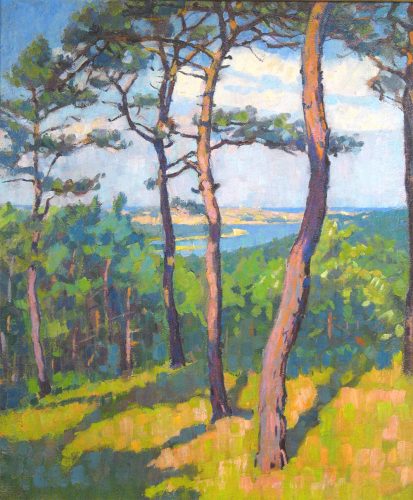
Margaret Patterson, Salt Creek, Cape Cod, oil on canvas

